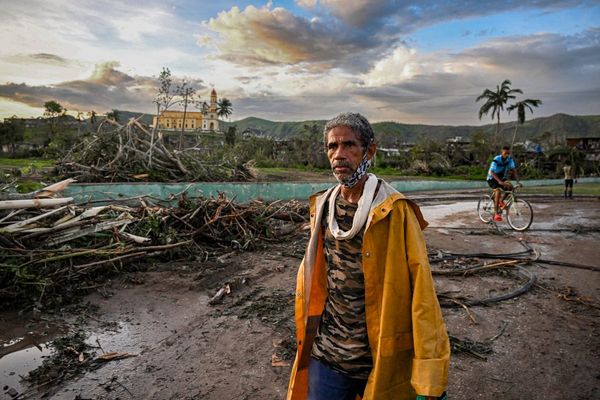
There is no shortage of things to say about what’s going wrong. The extent of damage caused at 1.2C of global heating since pre-industrial levels is proving greater than was forecast by climate scientists not that long ago.
As discussed last week, the disastrous toll of the historic flooding in Pakistan and heatwaves and droughts across the northern hemisphere summer appear signs of escalation. A peer-reviewed study found several disastrous climate tipping points, including the collapse of Greenland’s ice cap and Gulf Stream currents in the Atlantic Ocean, may now be unavoidable.
But there is also evidence that action to combat the climate crisis is belatedly accelerating. Acknowledging that every fraction of a degree of global heating avoided makes a difference, here are some things to be positive about.
Falling emissions in China
While Australia’s emissions increased in the most recent data, China – the world’s biggest annual carbon polluter – recorded an 8% fall in the June quarter and a 3% cut year-on-year.
As reported by analyst Lauri Myllyvirta in Carbon Brief, the drop compared with the same period in 2021 was 230m tonnes – equivalent to nearly half Australia’s annual emissions, and the largest cut in Chinese carbon pollution in at least a decade. It was driven by both short and long-term trends: a real-estate slump, Covid-related restrictions, weak growth in electricity use and continued renewable energy expansion.
It is too early to say whether this is a permanent decline – a recently announced stimulus package may encourage construction and both clean and dirty energy use – but it is the fourth straight quarter in which pollution has fallen.
For all the talk that China is continuing to build coal-fired power plants, electricity generation from burning the dirty fuel was down by 4% in the first six months of the year. As with most types of infrastructure, the country is building more coal capacity than it needs.
This could yet be reversed, at least temporarily – coal-fired power has rebounded in recent weeks as hydro capacity slumped due to extreme drought and heat, and China’s commitment to the UN is that its emissions will peak before 2030.
Renewable energy – particularly solar – is happening
A report by the International Energy Agency (IEA) found more people are now employed in clean energy (which it defined as including renewable energy, electric vehicles, energy efficiency measures and nuclear power) than the fossil fuel industry. One small problem: clean energy jobs are not as well paid, in part because they are less likely to be unionised. But the argument that there are no jobs in clean energy has dissipated.
Clean energy investment has grown by 12% a year since 2020, in part due to the rise of public and private support for sustainable finance, especially in wealthy countries. Renewable energy, new grids and energy storage account for more than 80% of total power sector investment. The IEA estimates spending on solar, batteries and EVs is now growing at a rate consistent with reaching global net zero emissions by 2050.
In Europe, where Russia’s invasion of Ukraine has upturned the energy supply, there has been a significant swing towards renewable energy even while countries offer short-term support for fossil fuels to keep lights and heating on. The British thinktank Ember found a record northern summer of solar generation meant the continent was able to avoid spending €29bn($A43bn) on gas. Across the EU’s 27 countries, renewable energy provided 35% of electricity, compared to 16% from coal.
According to an analysis by Bloomberg NEF, manufacturing of solar polysilicon – the semiconductor used in photovoltaic panels – is happening so rapidly that the entire supply chain needed to bring emissions to a halt is already under construction. It’s nearly all in China – just one of many potential complications outlined by Bloomberg’s David Fickling – but it says something about what is achievable.
The rich are finally starting to step up (in some ways)
There has been no agreement at UN climate talks on the rich paying up to help the developing world deal with the unavoidable loss and damage caused by global emissions, but the wealthy are finally moving to drive a clean energy transition in some of the countries that will matter.
The goal is pretty simple – to give major rising emitters the financial and other support needed so their economic expansion steers away from fossil fuels. A template deal was announced at the Cop26 climate summit in Glasgow, when South Africa signed a partnership Germany, the UK, the US, and the EU that promises $US8.5bn of global capital over the next three-to-five years as the country restructures its coal-dependent energy system.
In June, the G7 confirmed a larger goal – to access up to $US600bn in public and private finance over five years for clean energy infrastructure in countries including Indonesia, India, Senegal and Vietnam. Along with other steps, such as G20 countries promising to stop financing new coal power overseas and the Asian Development Bank’s energy transition mechanism, it could re-draw what is possible. Ensuring local communities are not exploited or left behind in the process will be vital for its success.
The US landed its white whale
This is arguably the greatest reason for optimism this year. After years of trying and failing, the US – the biggest historic emitter – has passed major climate change legislation through its Congress. Analysis has found the Inflation Reduction Act (IRA) could propel the country to a 43% cut in emissions by 2030 compared with 2005 levels – a big leap from where it was otherwise headed. If its political system holds together it should put the national target of a 50% cut this decade, and bigger cuts beyond, within reach.
One key point to note: the US law underlines that penalising fossil fuel industries by pricing carbon is, while not dead, out of fashion. The IRA is mostly about investment – $US370bn of it – to help clean solutions usurp the old, dirty model. Much of it will be available only to goods manufactured in the US. Experts say in addition to cutting local pollution, this could also increase competition and lower costs on international markets.
Australia is no longer a complete laggard
Compared with the US, the passing of Australia’s first climate change legislation in a decade is minor news – it is a smaller country and a more modest bill – but it is still unarguably one of the positives stories of the moment.
After years of Australia being bracketed with Russia and Saudi Arabia as a global laggard, the Albanese government will win praise for its new 2030 emissions reduction target (a 43% cut compared with 2005) at the next major UN climate summit in Egypt in November.
But the Labor government can also expect questions. The most pertinent is likely to be the same one it is getting at home: will it really undermine its new commitment, and the global effort, by continuing to expand fossil fuel exports? It might need to develop a better answer.
Adam Morton is Guardian Australia’s climate and environment editor.







